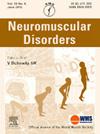Investigating phenotypic variability patterns in myotonic dystrophy type 2 in a neuromuscular referral center retrospective cohort
IF 2.7
4区 医学
Q2 CLINICAL NEUROLOGY
引用次数: 0
Abstract
We aimed at investigating the presence of patterns that account for the phenotypic variability in a myotonic dystrophy type 2 (DM2) retrospective cohort at the Mass General Brigham Neuromuscular Centers. We collected the presence or absence of 23 clinical variables at symptom onset and diagnosis (n = 67 patients) and follow-up (n = 37 patients). We first identified set/s of variables (factors or cluster/s) representative of the large research data pool at onset by performing factor analyses, then assigned each patient to the cluster for which they had the highest computed total factor score. Twelve variables grouped into two distinct clusters that, based on their variable content, we named as proximal myotonic myopathy (PROMM)-DM2 or non-PROMM-DM2. Patients assigned to non-PROMM-DM2 more frequently had clinical myotonia and positive family history, and less frequently multiorgan involvement. Most patients (67.2 %) remained assigned to same cluster during disease course and 11 non-PROMM eventually transitioned to PROMM-DM2. Dyslipidemia and early cataracts (both in PROMM-DM2 cluster) were the earliest extramuscular manifestations that occurred during disease course and they accounted for the conversion of up to 8 out of 11 non-PROMM to PROMM converters. Identification of phenotypically homogeneous patient subgroups may help investigating DM2 prognosis and disease biomarkers in future prospective studies.
在神经肌肉转诊中心回顾性队列研究2型肌强直性营养不良的表型变异模式。
我们的目的是调查在麻省总医院布里格姆神经肌肉中心的2型肌强直性营养不良(DM2)回顾性队列中存在的解释表型变异的模式。我们收集了23个临床变量在症状发作和诊断(n = 67例)和随访(n = 37例)时的存在或不存在。我们首先通过进行因素分析,确定了在发病时具有代表性的大型研究数据池的变量集(因素或聚类),然后将每位患者分配到计算总因素得分最高的聚类。12个变量分为两个不同的集群,基于其变量的内容,我们将其命名为近端肌强直性肌病(PROMM)-DM2或非PROMM-DM2。分配到非promm - dm2组的患者更频繁地出现临床肌强直和阳性家族史,而多器官受累的频率更低。大多数患者(67.2%)在病程中仍被分配到同一组,11例非promm最终过渡到PROMM-DM2。血脂异常和早期白内障(均属于PROMM- dm2集群)是疾病过程中最早出现的肌外表现,11例非PROMM转化为PROMM的患者中有8例是由它们引起的。在未来的前瞻性研究中,确定表型均匀的患者亚组可能有助于研究DM2预后和疾病生物标志物。
本文章由计算机程序翻译,如有差异,请以英文原文为准。
求助全文
约1分钟内获得全文
求助全文
来源期刊

Neuromuscular Disorders
医学-临床神经学
CiteScore
4.60
自引率
3.60%
发文量
543
审稿时长
53 days
期刊介绍:
This international, multidisciplinary journal covers all aspects of neuromuscular disorders in childhood and adult life (including the muscular dystrophies, spinal muscular atrophies, hereditary neuropathies, congenital myopathies, myasthenias, myotonic syndromes, metabolic myopathies and inflammatory myopathies).
The Editors welcome original articles from all areas of the field:
• Clinical aspects, such as new clinical entities, case studies of interest, treatment, management and rehabilitation (including biomechanics, orthotic design and surgery).
• Basic scientific studies of relevance to the clinical syndromes, including advances in the fields of molecular biology and genetics.
• Studies of animal models relevant to the human diseases.
The journal is aimed at a wide range of clinicians, pathologists, associated paramedical professionals and clinical and basic scientists with an interest in the study of neuromuscular disorders.
 求助内容:
求助内容: 应助结果提醒方式:
应助结果提醒方式:


